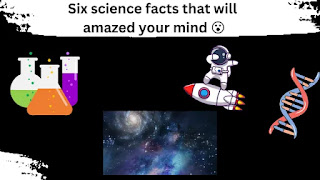How do plants know when to flowers? How can a tiny hummingbird fly all the way to South America and back? Science has the answers to these questions and more. In this blog post, we will explore six science facts that will leave you amazed. From the weird world of quantum mechanics to the secrets of animal navigation, read on to learn more about the wonderful world of science.
Science Facts 1:The universe is expanding
The universe is expanding. This means that the distance between galaxies is increasing over time. The speed at which the universe is expanding is called the Hubble constant. The most recent measurements of the Hubble constant suggest that the universe is expanding at a rate of about 70 kilometres per second per megaparsec. (A megaparsec is a unit of distance equal to one million parsecs, or 3.26 million light-years.)
This discovery has important implications for our understanding of the universe. For example, it means that the universe will continue to expand forever. It also suggests that there was a time in the past when all of the matter in the universe was concentrated in a single point. This event is known as the Big Bang.
Science Facts 2:The sun will eventually die☹️
The sun is a star and, like all stars, it will one day die. Stars are fueled by nuclear fusion, which occurs when atoms combine to form new atoms. The sun converts hydrogen into helium. Helium is much lighter than hydrogen, so it escapes the sun's gravity and floats out into space. This process makes the sun shine and also creates huge amounts of energy.
eventually run out of hydrogen. At that point, the sun will start to convert helium into carbon. This process is called nuclear fusion. Nuclear fusion is when two atoms join together to form one larger atom. The sun will continue to get bigger and brighter as it converts more and more helium into carbon.
Eventually, the sun will get so big that it will engulf Earth! But don't worry, this won't happen for billions of years.
So what does this all mean? It means that the sun will eventually die but not for a very long time!
Science Facts 3: Earth is not the only habitable planet😍
There are an estimated 100 billion planets in the Milky Way galaxy alone. And there could be billions more in other galaxies. So it stands to reason that Earth is not the only habitable planet.
There are several factors that make a planet habitable, including its distance from its star, its size and composition, and the presence of water. And while we have not yet found any other planets that meet all of these criteria, we have found several that come close.
Some of the most promising candidates for habitability are the exoplanets Kepler-186f and Kepler-62f. Both are about the same size as Earth and orbit stars that are similar to our Sun. And while we don't know for sure if they have water, they both lie within what is known as the "habitable zone" – meaning that if they do have water, it could be in liquid form.
Other potential habitable planets include Proxima Centauri b, which orbits our nearest stellar neighbour, Proxima Centauri; TRAPPIST-1d, which is one of seven planets orbiting the ultra-cool dwarf star TRAPPIST-1; and LHS 1140b, which was discovered earlier this year and boasts many similarities to Earth.
So while Earth may be the only habitable planet in our solar system, it is certainly not the only one in the universe. And with new discoveries being made all the time, it's possible that we'll find another planet just like
Science Facts 4: There are more galaxies than there are stars in the Milky Way😍
There are more galaxies in the universe than there are stars in the Milky Way. This is because the universe is much bigger than our galaxy. In fact, there are billions of galaxies in the universe! There are an estimated 100-200 billion galaxies in the observable universe. In comparison, there are only an estimated 100-400 billion stars in the Milky Way. This means that, for every star in our galaxy, there are at least two galaxies out there.
Science Facts 5:Most of the universe is dark matter
Most of the universe is dark matter. It's a fact. The vast majority of the mass in the universe is invisible to us. Dark matter does not emit light, so we can't see it. We can only detect its presence by its gravitational effects on visible matter.
Some scientists believe that dark matter is made up of hypothetical particles called WIMPs (Weakly Interacting Massive Particles). Others think it could be composed of something called axions. But we still don't know for sure what dark matter is made of.
What we do know is that dark matter plays a vital role in the structure and evolution of the universe. Without it, galaxies would not form and life as we know it would not exist.
Science Facts 6:Helium has the ability to work against gravity😮
When Helium is cooled to almost absolute zero (-273°C) , it becomes a liquid with surprising properties. It flows against gravity and will start running up the walls of its container,it becomes a superfluid, which means it can flow without friction. A superfluid is a liquid with zero viscosity that can flow freely without any resistance.
Superfluids are found in nature, and have also been created in laboratories. They are strange and fascinating substances, with some very unusual properties.
Superfluids are unique because they have no shear stress. This means that they can flow freely without any resistance. They can also climb walls and flow uphill!
Conclusion
From the complex inner workings of the human brain to the infinite depths of space, there is an endless amount of scientific information out there for us to explore. We hope these six science facts have helped you learn something new and inspired you to continue learning about our amazing world. What other science facts do you find fascinating? Share them with us in the comments below!










0 Comments
I love to read your comments. Please comments